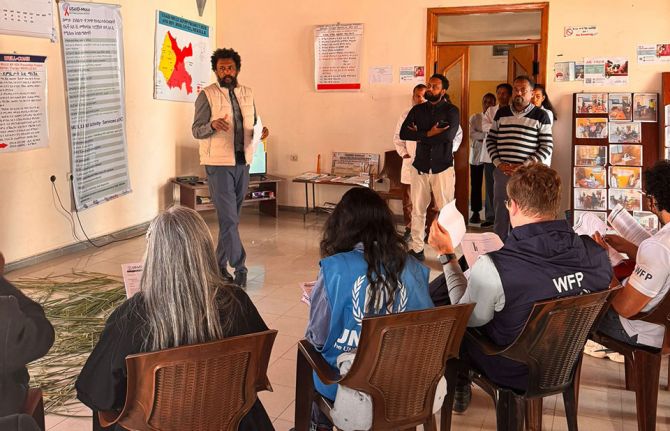





Feature Story
Resilience amid crisis: strengthening the HIV response for displaced communities in Ethiopia
02 December 2024
02 December 2024 02 December 2024Ethiopia faces a triple crisis of conflict, climate change, and displacement that impedes the capacity to provide essential health and other humanitarian assistance to those in need, including people living with HIV.
With support from 2Gether 4 SRHR, UNAIDS and partners recently organised a joint mission to learn about the humanitarian response and to identify the challenges that persist. The findings of the mission will help update the guidelines on Addressing HIV in Humanitarian Settings, a crucial resource for all actors working on HIV in emergency settings, providing evidence-based recommendations for integrating HIV into the different sectors of humanitarian responses.
Ethiopia hosts more than 1 million refugees, predominantly from South Sudan, Somalia, Eritrea and Sudan, the majority of whom live in 24 refugee camps established across five regional states, and 80,000 of whom reside in the capital Addis Ababa. In addition, the country has 4.4 million internally displaced persons (IDPs) and over 1.5 million IDP returnees.
The team visited two of the regions hardest hit by humanitarian crises, grappling with rising HIV rates: Tigray and Gambella. In Tigray, just 5 kilometers from the capital Mekelle, lies Seba Kare (70 Kare) IDP camp—a settlement hosting over 20,000 people displaced by the conflicts in the western and eastern parts of the region. Seba Kare represents both the resilience of its inhabitants and the dire challenges of prolonged displacement. The camp, initially intended as temporary shelter for six months, has now housed many families for over four years. Cramped conditions, insufficient food, limited access to education, and inadequate healthcare services are daily realities for residents. Despite the tireless efforts of humanitarian partners on the ground, the growing needs of the displaced population far exceed the resources available.
Among the most pressing gaps is the lack of comprehensive healthcare, particularly for people living with HIV. In humanitarian crises, critical services for HIV and sexual and reproductive health are often sidelined, overshadowed by the urgent need for food, shelter, and disease control. Healthcare is restricted to primary services. Care for chronic conditions, such as HIV, is referred to government hospitals. This means that all patients, IDP or not, must pay for transportation as well as services and purchase vital medical supplies on their own—an impossible burden for many.
Despite the continuous advocacy efforts in support of the decentralization of services and outreach interventions at camp-level, government-owned facilities outside the camp remain the only viable option for IDPs in need of health services.
The refugee camp of Jewi—in the western province of Gambella which has the highest HIV burden across Ethiopia—is equipped with its own antiretroviral therapy center. However, like in Tigray, Gambella faces significant challenges in providing HIV testing and treatment. Limited mobility within and beyond the camps, due to the costs of transport for clients and a shortage of ambulances in medical emergencies, combined with resource constraints at health centres, often results in treatment interruptions and high rates of loss to follow-up.
Adding to the crisis, the recent reduction in donor funding has severely impacted the quality of health services in the camps. The gender-based violence (GBV) center run by International Medical Corps will soon close due to funding cuts, leaving no other GBV services available outside of health services.
The situation for women and youth in Gambella is especially concerning. Limited educational and employment opportunities, compounded by rising HIV infections, put them at higher risk of infection due to the adoption of negative coping mechanisms, including substance abuse. The high rates of new HIV infections exacerbate these existing challenges, underscoring the urgent need for sustained interventions to improve health services, livelihoods, and social inclusion for refugees and host communities in the region. “There are many young and vulnerable people who need protection, shelter, food, income, education – and HIV prevention, testing, treatment and care. We must make sure to rebuild health and social services and fill the current resources gap,” said Tina Boonto, UNAIDS Ethiopia Country Director.
As international organisations step up their efforts to address HIV in humanitarian settings, there is a coordinated push in Ethiopia, at both the federal and regional levels, to ensure that the health needs of people living with HIV are met, even in the most challenging circumstances. The Ministry of Health, with support from UNAIDS, is developing an HIV Baseline Survey in Humanitarian Settings and a comprehensive National HIV/Sexual and Reproductive Health Guiding Document. This initiative is a substantial step towards safeguarding the rights and well-being of people living with HIV across the country.
"Ethiopia's progress in addressing HIV is inspiring,” said Maheswari P Murugayia, Public Health Officer and Global HIV Focal Point at UNHCR. “Tackling HIV in humanitarian settings is not just a priority— it’s a necessity for ensuring the health and well-being of displaced populations.”



